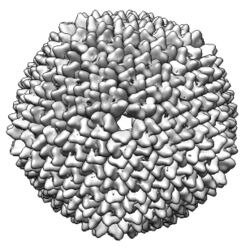Biology:Tectivirus
| Tectiviridae | |
|---|---|

| |
| CryoEM model of Enterobacteria phage PRD1 capsid. PDB entry 1gw7[1] | |
| Virus classification | |
| (unranked): | Virus |
| Realm: | Varidnaviria |
| Kingdom: | Bamfordvirae |
| Phylum: | Preplasmiviricota |
| Class: | Tectiliviricetes |
| Order: | Kalamavirales |
| Family: | Tectiviridae |
| Genera | |
|
See text | |
Tectiviridae is a family of viruses with 10 species in five genera. Bacteria serve as natural hosts.[2][3] Tectiviruses have no head-tail structure, but are capable of producing tail-like tubes of ~ 60×10 nm upon adsorption or after chloroform treatment. The name is derived from Latin tectus (meaning 'covered').[4]
Virology
The virions of Tectiviridae species are non-enveloped, icosahedral and display a pseudo T=25 symmetry.[2] The capsid has two layers. The outer layer is a protein structure of 240 capsid proteins trimers, and the inner one is a proteinaceous lipid membrane which envelopes the virus genome. Apical spikes extending about 20 nanometers (nm) protrude from the icosahedrons vertices.[citation needed]
The genome is a single molecule of linear double-stranded DNA of 15 kilobases in length, and has 30 open reading frames.[2] It forms a tightly packed coil and encodes several structural proteins. It encodes about 30 proteins that are transcribed in operons. At least 9 structural proteins are present in the viron. The genome is about 66 megadaltons in weight and constitutes 14–15% of the virion by weight. Lipids constitute a further 15% by weight. Carbohydrates are not present.[citation needed]
Life cycle
Viral replication is cytoplasmic. Entry into the host cell is achieved by adsorption into the host cell.[2] After adsorption to the host cell surface the virion extrudes a tail-tube structure through a vertex for genome delivery into the host. Replication follows the DNA strand displacement model. DNA-templated transcription is the method of transcription.[2] Capsid proteins polymerize around a lipoprotein vesicle translocated in the cytoplasm by virion assembly factors.
Mature virons are released by lysis, which, in the case of PRD1, is achieved with the aid of virus-encoded lysis machinery consisting of four proteins: P15 (endolysin),[5] P35 (holin),[6] P36 and P37 (homologues of the Rz/Rz1 proteins of phage lambda).[7]
Taxonomy
Tectiviridae contains the following genera and species:[3]
- Alphatectivirus
- Pseudomonas virus PR4
- Pseudomonas virus PRD1
- Betatectivirus
- Bacillus virus AP50
- Bacillus virus Bam35
- Bacillus virus GIL16
- Bacillus virus Wip1
- Deltatectivirus
- Streptomyces virus Forthebois
- Streptomyces virus WheeHeim
- Epsilontectivirus
- Rhodococcus virus Toil
- Gammatectivirus
- Gluconobacter virus GC1
Other unassigned phages:[8]
- Thermus virus phiKo
- Microbacterium virus Badulia
- Microbacterium virus MuffinTheCat
References
- ↑ San Martín, C; Huiskonen, JT; Bamford, JK; Butcher, SJ; Fuller, SD; Bamford, DH; Burnett, RM (2002). "Minor proteins, mobile arms and membrane-capsid interactions in the bacteriophage PRD1 capsid". Nature Structural Biology 9 (10): 756–63. doi:10.1038/nsb837. PMID 12219080.
- ↑ 2.0 2.1 2.2 2.3 2.4 "Viral Zone". ExPASy. http://viralzone.expasy.org/all_by_species/579.html.
- ↑ 3.0 3.1 "Virus Taxonomy: 2020 Release". International Committee on Taxonomy of Viruses (ICTV). March 2021. https://ictv.global/taxonomy.
- ↑ "ICTV Ninth Report; 2009 Taxonomy Release: Tectiviridae". https://talk.ictvonline.org/ictv-reports/ictv_9th_report/dsdna-viruses-2011/w/dsdna_viruses/133/tectiviridae.
- ↑ "Gene XV of bacteriophage PRD1 encodes a lytic enzyme with muramidase activity". Eur J Biochem 225 (1): 341–346. 1994. doi:10.1111/j.1432-1033.1994.00341.x. PMID 7925454.
- ↑ "Identification and mutational analysis of bacteriophage PRD1 holin protein P35". J Bacteriol 185 (13): 3795–3803. 2003. doi:10.1128/JB.185.13.3795-3803.2003. PMID 12813073.
- ↑ "Identification and functional analysis of the Rz/Rz1-like accessory lysis genes in the membrane-containing bacteriophage PRD1". Mol Microbiol 68 (2): 492–503. 2008. doi:10.1111/j.1365-2958.2008.06165.x. PMID 18366440.
- ↑ Unclassified Tectiviridae. NCBI Taxonomy.
Further reading
- ICTVdB—The Universal Virus Database ICTVdB Management (2006). 00.068. Tectiviridae. In: ICTVdB—The Universal Virus Database, version 3. Büchen-Osmond, C. (Ed), Columbia University, New York, USA
- Virus Taxonomy: Eighth Report of the International Committee on Taxonomy of Viruses H.V. Van Regenmortel, D.H.L. Bishop, M. H. Van Regenmortel, Claude M. Fauquet (Eds)
- 68.0.1. Tectivirus
External links
Wikidata ☰ Q569755 entry
 |


